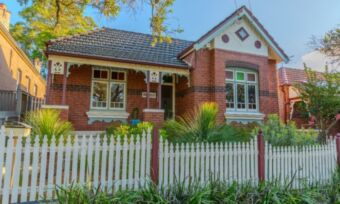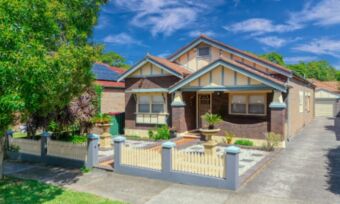How much does it cost to landscape your backyard?
A beautiful outdoor space can really make a house a home or catch the eye of a potential buyer, but how much does it cost to landscape? We break down the average prices you can expect to pay when budgeting for a landscaping project, as well as the type of work involved.

A beautiful outdoor space can really make a house a home or catch the eye of a potential buyer, but how much does it cost to landscape? We break down the average prices you can expect to pay when budgeting for a landscaping project, as well as the type of work involved.
What is landscaping?
Landscaping has been practiced for thousands of years, dating as far back as the ancient Mayans, according to science magazine EOS. These days, landscaping refers to the design and construction of front and backyards and other green spaces to enhance appearance and functionality.
Landscaping is an activity where many preferences can be considered, such as:
- Colour — Is there a specific colour scheme?
- Decor — Are you looking to install a fountain or sculpture?
- Plants & flowers — What types are you after?
- Design — How do you want your yard to look?
- Climate — Does your location’s weather only allow certain plants/flowers to flourish?
- The season — What time of year are you landscaping? How much sunlight a day does your yard get?
The comparison rate for all home loans and loans secured against real property are based on secured credit of $150,000 and a term of 25 years.
^WARNING: This comparison rate is true only for the examples given and may not include all fees and charges. Different terms, fees or other loan amounts might result in a different comparison rate.
 Owner occupied
Owner occupied
 20% min deposit
20% min deposit
 Redraw facility
Redraw facility
 Owner occupied
Owner occupied
 30% min deposit
30% min deposit
 Redraw facility
Redraw facility
Canstar may earn a fee for referrals from its website tables, and from Sponsorship or Promotion of certain products. Fees payable by product providers for referrals and Sponsorship or Promotion may vary between providers, website position, and revenue model. Sponsorship or Promotion fees may be higher than referral fees. Sponsored or Promoted products are clearly disclosed as such on website pages. They may appear in a number of areas of the website such as in comparison tables, on hub pages and in articles. Sponsored or Promoted products may be displayed in a fixed position in a table, regardless of the product’s rating, price or other attributes. The table position of a Sponsored or Promoted product does not indicate any ranking or rating by Canstar. For more information please see How We Get Paid.
Should I landscape?
Though the idea of a beautiful lawn, abundant flowers and an eye-catching design can make us want to dig into our wallets, navigating the details of a landscaping project prior to development can help ensure you’re adding value to your home without negatively impacting your property’s space, or the surrounding environment.
According to landscape economist John Harris, good landscaping can increase your property’s value by up to 28%. However, the former Director and General Manager of online lender State Custodians, Gavin Smith, does warn a complicated design can throw off potential buyers all together and recommends keeping it simple.
The potential value increase to your home is definitely an incentive, but it might not be the only reason you want to improve your yard. Popular reasons for landscaping can include:
- A way to reduce stress, be it through DIY gardening or by giving yourself a nice place to sit and enjoy nature.
- Adding additional privacy to your house.
- Reducing heating and cooling costs (more time outside generally means less time using heaters and air conditioners).
- Wanting a more inviting, entertaining area for use with friends and family.
Deciding whether or not to landscape your yard can also come down to factors such as cost and location. Take for example Queensland: If you were to landscape a yard in the sunshine state, you’d be wise to consider possible water restrictions and heat waves before finalising your desired foliage and layout, potentially preventing financial heartache for your bank account. Conducting thorough research can be beneficial in making sure no time or money is wasted.
How much does garden landscaping cost?
According to trade services website Hipages, a completely professional landscaping job can cost an estimated 5% to 10% of the total value of your property. For example, if your home is valued at $800,000, Hipages recommends setting aside $40,000 to $80,000 for landscaping. This may seem like a lot, but landscaping can include the creation of driveways, decking, retaining walls and patios.
Hipages also says that for an average Aussie home, a 5% budget typically gets you a clean garden design with plant suggestions and labour. For 10% you can have something more complex, that may include water features, cabanas or fire pits with integrated seating. Creating a swimming pool may also be a part of your landscaping dreams, but isn’t usually included in these general landscaping estimates due to their overall cost and complexity. The following estimated costs were sourced from Hipages:
Estimated general landscaping costs
- $250 for a consultation with a landscape architect.
- $850 for garden designs (basic plans).
- $2,750 to $6,000 for 10 x A3 pages of design work (which usually includes some 3D rendering).
- $55 to $70 per labour hour to hire an experienced, qualified landscaper.
Estimated decking costs
This can include both the supply and installation of decking. Costs are based on 140mm wide board top fixed with screws, with a treated pine sub frame, concrete stumps and M class footings:
- From $200 per square metre for treated pine.
- $280 to $320 per square metre for Merbau (a popular sturdy hardwood from South East Asia).
- $350 and above per square metre for composite decking.
Estimated paving costs
This can include both the supply and installation of paving. Costs are based on a 100mm concrete base with mortar gaps and steel reinforcement. To find out how much a path would cost, measure the length and width of your desired space and multiply it by the cost of the material you want.
- $50 to $70 per square metre for plain concrete.
- $70 to $90 per square metre for brick.
- $280 to $350 per square metre for Bluestone (also called Basalt), which is a form of volcanic stone.
- $18 per metre to seal your chosen paving.
Estimated driveway costs
This can include both the supply of materials and installation of the driveway itself:
- $65 to $85 per square metre for plain concrete.
- $75 to $95 per square metre for coloured concrete.
- $100 to $150 per square metre for exposed aggregate (a more decorative form of concrete).
Estimated feature costs
- From $2,000 for a new deck.
- From $5,000 for a conversation pit with paving and built-in seating.
- From $9,000 for a water feature.
- Between $25,000 and $100,000 for a pool.
Certainly, all of these costs can vary depending on factors such as the size of the project, the ease of access to the area, the type of features and materials you want (type of plants, lawn, paving etc.) and the complexity of the work itself.
How much does gardening cost?
If you’re interested in just general gardening rather than a larger landscaping project, you can expect to pay between $40 to $60 per hour for labour according to the online services platform Airtasker. Rates for more complex gardening can range from $100 to $500 per hour. The estimated cost for other gardening services according to Airtasker are:
- Garden cleanup or maintenance: $50 to $250 per hour.
- Garden waste removal: $60+ per hour.
- Weed control: $50 to $180 per job.
- Weed spraying: $30 to $40 per hour.
- Hedge cutting: $40 to $70 per hour.
- Garden or lawn fertilising: $30 to $50 per hour.
Who should I hire to landscape my garden?
According to Hipages, there are various professionals who can assist in garden landscaping, these include:
- Landscape architect – Usually focussed on the design and planning, they are a licensed professional hired mainly for larger-scale projects where many elements are desired and technical and legal expertise may be required.
Estimated cost: $80 to $150/hr.
- Landscape designer – Though having similar skills to a landscape architect, a landscape designer will usually work on smaller projects and focus on aesthetics and functionality, rather than technical compliance.
Estimated cost: $500 to $1,500 for a small garden, $1,500 to $3,500 for a medium-sized space, $3,500 to $6,500 for a larger area and $10,000 or more for complex designs.
- Landscape contractor – Contractors are often engaged to undertake manual landscaping works and can also provide advice as well as give practical insights.
Estimated cost: $55 to $70/hr.
Often, if you are undertaking a larger project, you may wish to engage both a landscape designer or architect alongside a contractor to manage and execute the final design.
What are the options to finance landscaping?
How you finance your landscaping project may depend on how large the job is and its total cost. There are several options to consider, including:
Home loan
If the project is big enough, or you are undertaking multiple jobs at the same time, one option to consider is refinancing or restructuring your home loan, or adding a ‘line of credit’. For example, depending on your lender you may be able to add a redraw facility to your existing loan (although it’s wise to keep in mind that some fees could apply to any loan changes and there could be redraw limits). Alternatively, you could add an offset account, which could help reduce the interest paid on your loan while still allowing access to your money (but keep in mind there could be some fees involved here too, and higher interest rates could apply to these types of loans).
Personal loan
Depending on your personal circumstances and the cost of your landscaping project, you may consider using a personal loan to fund the work. This could be a secured loan or an unsecured loan. It’s worth keeping in mind, though, that interest rates are generally higher for personal loans than for home loans, and it’s a good idea to read the lender’s terms and conditions first. These can be found in the Product Disclosure Statement (PDS).
Credit card
It may also be possible, depending on the cost and your ability to repay the debt quickly, to pay for your landscaping project using a credit card. There could be some fringe benefits for doing so, such as extra insurance cover in some cases (read the card’s PDS to find out the conditions of the cover).
Keep in mind that credit card interest rates are typically much higher than home or personal loans, and interest can quickly accumulate on large balances, so it can be a good idea to weigh up your options carefully. If you don’t think you’ll be able to pay off the card’s balance in full each month, it may be worth re-considering whether a credit card is the right option.
Is landscaping a DIY project?
Whether or not you can execute your own landscaping depends on many factors, including your skill level, the complexity of the job and the size of the area in question. While there are many people who do their own DIY yard upgrades, using a professional landscaper can generally ensure your new garden is planned properly, adheres to your budget and meets your preferences, as well as any legal requirements you may encounter.
Before undertaking a DIY task, you may want to consider evaluating these points:
- Analyse your skillset – What is your experience? Have you done similar DIY work in the past?
- Do you have the tools? – Having the necessary tools and safety equipment to perform the DIY work can be an important consideration, as buying new tools specifically for the job may be costly.
- Figuring out your style – Comparing your style and landscaping aspirations to the current condition of your yard can help determine whether or not you can undertake a DIY project.
- Break down pricing – Create a plan, even with a designer, before starting a landscaping project. This could help to figure out whether you can afford to hire the relevant landscaping professionals.
Even if you’re enthusiastic about your new project and see yourself as a DIY connoisseur, these type of projects may require the help of a professional, such as a licensed tradesperson, for:
- Permits and planning.
- Porches, patios and decks.
- Lighting, wiring and electrical work.
- Pools and water features.
Don’t worry as there are many simpler DIY tasks you might be able to undertake that don’t typically require a professional, such as:
- Cleaning — raking leaves, getting rid of any fallen branches and hosing down and/or pressure washing any concrete or other pathways.
- Removal of any dead annuals (flowers that perform their entire life cycle within one season).
- Pruning your shrubs (cutting the shrub in a specific way to control its growth and pattern).
- Straighten up any planting beds — remove any debris, rake to move the soil and pull out any weeds.
- Planting trees, shrubs and flowers.
- Creating a stone path for a rustic vibe.
- Building a stylish seating area for entertaining.
Cover image source: Serhii Krot/Shutterstock.com
This article was reviewed by our Jessica Pridmore before it was updated, as part of our fact-checking process.

Nick’s role at Canstar allows him to combine his love of the written word with his interest in finance, having learned the art of share trading from his late grandfather. Nick strives to deliver clear and straightforward content that helps the everyday consumer navigating the world of finance. Nick is also working on a TV series in his spare time. You can connect with Nick on LinkedIn.
The comparison rate for all home loans and loans secured against real property are based on secured credit of $150,000 and a term of 25 years.
^WARNING: This comparison rate is true only for the examples given and may not include all fees and charges. Different terms, fees or other loan amounts might result in a different comparison rate.
 Owner occupied
Owner occupied
 20% min deposit
20% min deposit
 Redraw facility
Redraw facility
Try our Home Loans comparison tool to instantly compare Canstar expert rated options.





